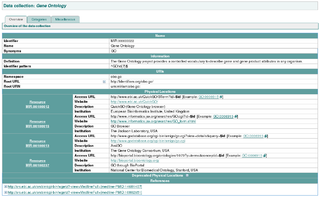In computing, a namespace is a set of signs (names) that are used to identify and refer to objects of various kinds. A namespace ensures that all of a given set of objects have unique names so that they can be easily identified.
A Uniform Resource Identifier (URI) is a unique sequence of characters that identifies a logical or physical resource used by web technologies. URIs may be used to identify anything, including real-world objects, such as people and places, concepts, or information resources such as web pages and books. Some URIs provide a means of locating and retrieving information resources on a network ; these are Uniform Resource Locators (URLs). A URL provides the location of the resource. A URI identifies the resource by name at the specified location or URL. Other URIs provide only a unique name, without a means of locating or retrieving the resource or information about it, these are Uniform Resource Names (URNs). The web technologies that use URIs are not limited to web browsers. URIs are used to identify anything described using the Resource Description Framework (RDF), for example, concepts that are part of an ontology defined using the Web Ontology Language (OWL), and people who are described using the Friend of a Friend vocabulary would each have an individual URI.

An identifier is a name that identifies either a unique object or a unique class of objects, where the "object" or class may be an idea, physical countable object, or physical noncountable substance. The abbreviation Id often refers to identity, identification, or an identifier. An identifier may be a word, number, letter, symbol, or any combination of those.

A Universally Unique Identifier (UUID) is a 128-bit label used for information in computer systems. The term Globally Unique Identifier (GUID) is also used, mostly in Microsoft systems.

An International Standard Serial Number (ISSN) is an eight-digit serial number used to uniquely identify a serial publication, such as a magazine. The ISSN is especially helpful in distinguishing between serials with the same title. ISSNs are used in ordering, cataloging, interlibrary loans, and other practices in connection with serial literature.
A Uniform Resource Name (URN) is a Uniform Resource Identifier (URI) that uses the urn scheme. URNs are globally unique persistent identifiers assigned within defined namespaces so they will be available for a long period of time, even after the resource which they identify ceases to exist or becomes unavailable. URNs cannot be used to directly locate an item and need not be resolvable, as they are simply templates that another parser may use to find an item.

Eur-Lex is an official website of European Union law and other public documents of the European Union (EU), published in 24 official languages of the EU. The Official Journal (OJ) of the European Union is also published on EUR-Lex. Users can access EUR-Lex free of charge and also register for a free account, which offers extra features.

A digital object identifier (DOI) is a persistent identifier or handle used to uniquely identify various objects, standardized by the International Organization for Standardization (ISO). DOIs are an implementation of the Handle System; they also fit within the URI system. They are widely used to identify academic, professional, and government information, such as journal articles, research reports, data sets, and official publications. DOIs have also been used to identify other types of information resources, such as commercial videos.
ISO/IEC 6523Information technology – Structure for the identification of organizations and organization parts is an international standard that defines a structure for uniquely identifying organizations and parts thereof in computer data interchange and specifies the registration procedure to obtain an International Code Designator (ICD) value for an identification scheme.
Life Science Identifiers are a way to name and locate pieces of information on the web. Essentially, an LSID is a unique identifier for some data, and the LSID protocol specifies a standard way to locate the data. They are a little like DOIs used by many publishers.
The Handle System is the Corporation for National Research Initiatives's proprietary registry assigning persistent identifiers, or handles, to information resources, and for resolving "those handles into the information necessary to locate, access, and otherwise make use of the resources".

An Archival Resource Key (ARK) is a multi-purpose URL suited to being a persistent identifier for information objects of any type. It is widely used by libraries, data centers, archives, museums, publishers, and government agencies to provide reliable references to scholarly, scientific, and cultural objects. In 2019 it was registered as a Uniform Resource Identifier (URI).
An Extensible Resource Identifier is a scheme and resolution protocol for abstract identifiers compatible with Uniform Resource Identifiers and Internationalized Resource Identifiers, developed by the XRI Technical Committee at OASIS. The goal of XRI was a standard syntax and discovery format for abstract, structured identifiers that are domain-, location-, application-, and transport-independent, so they can be shared across any number of domains, directories, and interaction protocols.
The Entertainment Identifier Registry, or EIDR, is a global unique identifier system for a broad array of audiovisual objects, including motion pictures, television, and radio programs. The identification system resolves an identifier to a metadata record that is associated with top-level titles, edits, DVDs, encodings, clips, and mashups. EIDR also provides identifiers for video service providers, such as broadcast and cable networks.

The MIRIAM Registry, a by-product of the MIRIAM Guidelines, is a database of namespaces and associated information that is used in the creation of uniform resource identifiers. It contains the set of community-approved namespaces for databases and resources serving, primarily, the biological sciences domain. These shared namespaces, when combined with 'data collection' identifiers, can be used to create globally unique identifiers for knowledge held in data repositories. For more information on the use of URIs to annotate models, see the specification of SBML Level 2 Version 2.
The European Legislation Identifier (ELI) ontology is a vocabulary for representing metadata about national and European Union (EU) legislation. It is designed to provide a standardized way to identify and describe the context and content of national or EU legislation, including its purpose, scope, relationships with other legislations and legal basis. This will guarantee easier identification, access, exchange and reuse of legislation for public authorities, professional users, academics and citizens. ELI paves the way for knowledge graphs, based on semantic web standards, of legal gazettes and official journals.
The European Case Law Identifier (ECLI) is an identifier for court decisions in Europe. The identifier consists of five elements separated by colons: ECLI:[country code]:[court identifier]:[year of decision]:[specific identifier]. The standard is laid down in the Council Conclusions inviting the introduction of the European Case Law Identifier (ECLI) and a minimum set of uniform metadata for case law of the European Union. The ECLI framework also contains a set of uniform metadata to improve search facilities for case law. Court decisions that have an ECLI assigned can be indexed by the ECLI Search Engine of the European e-Justice portal.
Identifiers.org is a project providing stable and perennial identifiers for data records used in the Life Sciences. The identifiers are provided in the form of Uniform Resource Identifiers (URIs). Identifiers.org is also a resolving system, that relies on collections listed in the MIRIAM Registry to provide direct access to different instances of the identified records.

LexML Brasil is a project of Brazil's Electronic Government initiative. Its objective is to establish open data systems, integrate work processes and share data, in the context of identifying and structuring executive, legislative and judiciary documents. The LexML-BR standards define a set of simple technology-neutral electronic protocols and representations, based on XML and HTTP ecossistem.
The Quake Markup Language (QuakeML) is a flexible, extensible and modular XML representation of seismological data which is intended to cover a broad range of fields of application in modern seismology.







